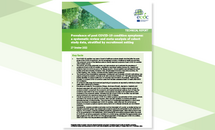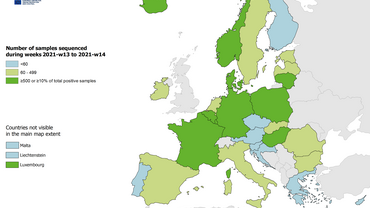Prevalence of post COVID-19 condition symptoms: a systematic review and meta-analysis of cohort study data, stratified by recruitment setting
The primary aim of this systematic review and meta-analysis was to estimate the prevalence of symptoms of post COVID-19 condition, stratified by recruitment setting (community, hospital and Intensive Care Unit (ICU)) as a proxy for disease severity.
Executive summary
- Post COVID-19 condition may pose a threat to healthcare systems already stretched after the acute phase of the COVID-19 pandemic, and its management remains a challenge to healthcare providers. This systematic review of the literature aims to identify reported symptoms of post COVID-19 condition within patient cohorts.
- The primary aim of this systematic review and meta-analysis was to estimate the prevalence of symptoms of post COVID-19 condition, stratified by recruitment setting (community, hospital and Intensive Care Unit (ICU)) as a proxy for disease severity. Only prospective and retrospective cohort studies conducted in Europe, European Union (EU)/European Economic Area (EEA) countries, the United Kingdom, USA, Canada, Australia and New Zealand were considered.
- The Grading of Recommendations Assessment, Development and Evaluation (GRADE) methodology was used to evaluate the certainty of evidence for each outcome of interest. Of 7 125 peer-reviewed studies initially identified, 61 cohort studies from 15 countries were included in the analysis. These studies included 74 213 post COVID-19 condition cases that had been assessed at least 12 weeks after SARS-CoV-2 infection.
- An extremely wide range of physical and psychological symptoms are reported by individuals at least 12 weeks after a SARS-CoV-2 infection.
- Prevalence estimates for five symptoms (fatigue, shortness of breath, depression, headache and dizziness) associated with post COVID-19 condition were supported by evidence scored as high or moderate certainty across both the community and hospital recruitment settings. Each of these five symptoms were noted to be more prevalent among patients recruited in the hospital setting when compared to the community setting, indicating that risk of post COVID-19 condition may be higher among individuals who experience more severe COVID-19 disease.
- Overall, the prevalence of any post COVID-19 condition symptom was estimated at 51% among cohorts recruited in the community setting. However, there was high variability in symptom prevalence estimates between individual studies. This is the result of considerable heterogeneity in cohort study designs developed to investigate post COVID-19 condition, which often lack the control groups necessary to compare symptoms reported among SARS-CoV-2 infected individuals and non-infected individuals.
- Consequently, symptom prevalence estimates must be interpreted with caution as studies lacking non-infected comparator groups may overestimate symptoms specifically attributable to prior SARS-CoV-2 infection. For example, a recently published prospective, population-based, observational cohort study of 76 422 participants in the Netherlands, which corrected for pre-existing symptoms before the onset of COVID-19, as well as symptomatic conditions in a control group, estimates that approximately one in eight people (12.7%) with COVID-19 in the general population will develop post COVID-19 condition, which is far lower than the prevalence estimated in this review.
- While this review may assist policymakers and public health authorities in estimating the burden of post COVID-19 condition and support the planning of rehabilitation services during the post-acute phase of the COVID-19 pandemic, there are important limitations to this work. Due to the time-lag between study design, implementation and publication, results in this systematic review reflect the status quo following the first waves of the pandemic (i.e. pre-Omicron period), where historical variants were in circulation and population-level immunity was markedly different.
- There are still many unknowns in terms of current and future population risk for post COVID-19 condition in the context of increased levels of vaccination and hybrid immunity. Looking ahead, additional large-scale population-based studies with appropriate control groups are required to assess the long-term symptoms specifically attributable to SARS-CoV-2 infection, and their association with a wide range of demographic and clinical risk factors.







